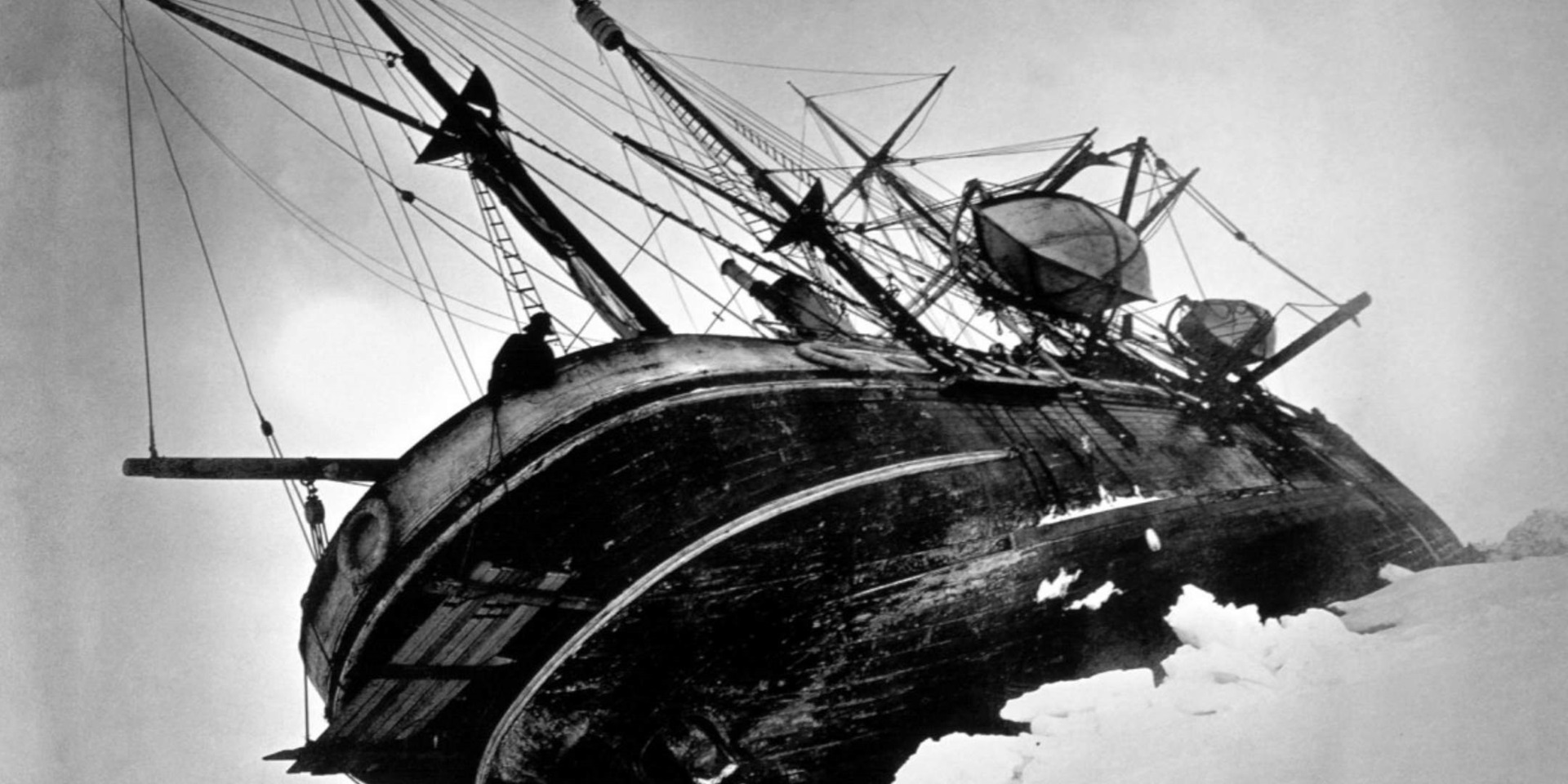
On 24 February, well aware of the jeopardy of his situation, Shackleton halted shipboard routine and turned his ship into a shore station.
Supplies were carefully conserved. The sledging dogs were moved into ‘dogloos’, ice kennels on the floe while the scientists and sledging parties moved from the deckhouse into ‘the Ritz’ — warmer cabins built in the cargo hold below the crew quarters.
The sailors built cairns (mounds of ice) around the ship to mark the way in blizzards. The men hunted penguins and seals, providing meat for men and dogs and fat for cooking and heating, and sourced drinking water from blocks of sea ice. They waited on the floe, hoping that it would split to free the ship or that they would drift towards land. Daily routines took only a few hours and in the uncertainty boredom was a threat to the morale of the men, and thence to the overall health and outcome of the expedition.
Crew in 'The Ritz'
'Dogloos' outside Endurance
Ice mounds linked with cable to guide the men during blizzard
Hurley skinning a penguin, with Shackleton beside the stove which he built on the floe
Nightwatch around the bogie fire on Endurance
Shackleton rose to the challenge, continually inspiring and varying activities. The men exercised with the dogs, training for sledging should the ship be freed. They played football and soccer and organised dog-sledge races, with Shackleton taking part.
Music was considered vital to cheer the men during what would be many months of isolation in the ice and the ship sailed with a gramophone, a very early portable music playing machine gifted by the HMV company, while meteorologist Leonard Hussey regularly played his banjo with sing-alongs, recitations and monthly ‘magic lantern chats’, illustrated talks by Frank Hurley, to entertain the men.
Eight months passed as Endurance’s ice floe zigzagged 3,000 kilometres, ending some 1,000 kilometres northwest of where the ship became trapped.
Chart showing the path of Endurance's drift and the escape route to Elephant Island, by geologist James Wordie, 1918. Library of Congress, g9801s ct000773 (via Wikimedia Commons)
With spring the floes loosened and jostled, and the ship convulsed from the pressure of the ice. Shackleton ordered abandon ship on 21 October. Six days later Endurance was crushed, and with it the dream to cross the continent. Frank Hurley noted on 27 October 1915:
Our ship has put up a valiant fight and done honour to her noble name Endurance … Before leaving, I went below … and found the waters swirling in and already a foot above the floor, the ribs disrupting and tongues of ice driving through the sides.
— Frank Hurley, Shackleton’s Argonauts, p 64, 1948
Endurance broken up in the ice, only a tangled mass of masts and rigging are visible.
Mere survival was now their only aim. Shackleton marshalled the 27 men and dogs to sledge to land, to the Antarctic Peninsula, Graham Land or Paulet Island, 650 kilometres northwest across the ice. Supplies had been left there by Nordenskjöld’s Swedish expedition crew marooned there after their ship Antarctic was beset in the ice and sunk in 1902. Progress proved impossible; the terrain was too difficult to cross. The 28 men managed only 2 kilometres a day, hauling the boats up and down ridges and ice hummocks.
Shackleton was now resigned to camping on the ice floe, their Ocean Camp, in the hope that it would carry them to safety.
Ocean or Patience Camp. Photograph: Frank Hurley. Courtesy Mitchell Library, State Library of New South Wales, a423091
The marooned men at Ocean Camp, 1915. Photograph: Frank Hurley. Courtesy Mitchell Library, State Library of New South Wales, a423088
Shackleton and Frank Wild made preparations to escape. Led by carpenter and shipwright ‘Chippy’ McNish, they organised strengthening and reinforcement of the ship’s three lifeboats. They also named them.
Ocean Camp showing men working on the James Caird in background
Raising the topsides of James Caird, Ocean Camp
Hauling James Caird to a lead to test modifications
James Caird with drying sleeping bags and blankets
Meals of heavily rationed supplies, supplemented by huge numbers of seals, penguins and even the expedition’s dogs, were cooked on a stove improvised by Frank Hurley from oil drums and fuelled by seal blubber or penguin skins.
One day we added 300 penguins to our larder … The skins reserved for fuel, the legs for hoosh, the breasts for steaks, and the livers and hearts for delicacies. A seal was consumed by the party with restrained appetites for five days – just as long as his blubber lasted to cook him.
— Frank Hurley, p 84
Men having a meal on arrival at Elephant Island. Frank Hurley photographer, courtesy Mitchell Library, State Library of New South Wales, a423099
After six long months the ice broke up beneath the men’s tents, while the ice pack opened and closed around them. The three lifeboats were launched and the men spent six days and nights in the Southern Ocean, fearful of killer whales, icebergs and huge seas, before reaching Elephant Island. All 28 men, thirsty, hungry and frostbitten, finally set foot on solid ground again after 17 months. Some went into a frenzy killing seals.
With little hope of rescue and winter looming, Shackleton immediately made plans to sail for rescue to South Georgia, 1,500 km northeast, aboard the largest of Endurance’s lifeboats, named James Caird. Anticipating a three-week passage, he took four weeks’ provisions — Bovril sledging rations (dried beef and fat), biscuit, powdered milk, sugar and nutfood (ground nuts and sesame oil), and several barrels of fresh water. He also selected Endurance captain Frank Worsley, second mate Tom Crean, sailor Tim McCarthy and two others — ‘Chippy’ McNish and John Vincent — practical additions to the crew who were also potential troublemakers to those left behind.
Launching James Caird from Elephant Island. Photograph by Frank Hurley. Courtesy Mitchell Library, State Library of New South Wales, a423098
In a remarkable feat of navigation, over 17 stormy days, Worsley, Shackleton and the small crew navigated the seven-metre boat to reach the island on 10 May. They arrived on the west coast, but the whaling stations were on the east. More than 40 kilometres of poorly charted, rugged mountains, glaciers and crevasses separated them. And they were exhausted.
Terrain at South Georgia — New Fortuna Glacier. Photograph: Frank Hurley. Courtesy Mitchell Library, State Library of New South Wales, a090021
Over 36 hours Shackleton, Worsley and second officer Tom Crean marched, climbed and glissaded (slid), taking several wrong turns, finally arriving in Stromness to the familiar steam whistle from the whaling station. They were unrecognisable to its manager, who had greeted them 18 months earlier on the voyage south. There they learnt of their supply party’s misadventures in the Ross Sea and that the war was not yet over.
Ruins of the whaling station at Stromness - Shackleton's destination at South Georgia.
